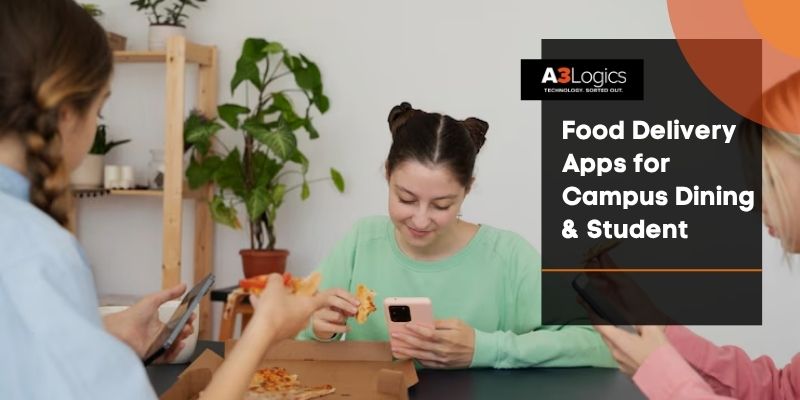Developing Food Delivery Apps for Campus Dining & Student Markets
Whether it’s late-night cravings, quick bites between lectures, or fuel for exam marathons, students today are a driving force behind the rising popularity of food delivery app. As campus life gets more digital and fast-paced, universities, food vendors, and startups are tapping into the student market with on-demand dining solutions.
Developing a food delivery app specifically for campus environments is a high-potential opportunity—but it requires understanding student behaviors, logistics, and tech expectations. Let’s break it all down.
Start with Market Research
Before writing a single line of code, get to know your audience. Students aren’t just any user base—they’re tech-savvy, value-driven, and operate on irregular schedules.
Key questions to explore:
- Are current cafeteria services outdated or slow?
- Are students ordering from third-party apps already?
- Is there demand for healthy, vegan, or budget food options?
Use on-campus surveys, cafeteria data, and competitor research to shape your app’s concept. The goal is to solve real pain points, not replicate what’s already out there.
Choose a Campus-Focused Business Model
Depending on your scope and goals, choose a model that aligns with how students eat:
- On-Campus Meal Delivery: Students order from dining halls, canteens, or campus cafés and have food delivered to dorms, libraries, or study lounges.
- Partner Restaurant Network: Collaborate with nearby eateries to offer exclusive student deals and deliveries within a fixed campus radius.
- Subscription Meal Plans: Let students pre-pay for a set number of meals per week or month at discounted rates—ideal for budget-conscious users.
You can even combine models to offer variety and convenience.
Must-Have Features for Students
Students want apps that are fast, simple, and rewarding. Your feature set should reflect this.
Customer App:
- Fast login with student email or ID
- Menu browsing with filters for dietary needs (vegan, gluten-free, etc.)
- Student-exclusive deals and promo alerts
- Loyalty points and digital wallet integration
- Scheduled delivery during class breaks
- Contactless drop-off at dorms or pickup stations
Admin/Restaurant Dashboard:
- Student ID verification & tracking
- Menu and meal plan configuration
- Advanced reporting (peak hours, popular meals, etc.)
- Vendor management panel
Delivery Partner App:
- Campus route optimization
- Dorm/building navigation
- Earnings dashboard
- Chat with customer support or students
Build features that make student life easier, not just another app.
Pick the Right Technology Stack
Your tech stack should prioritize speed, reliability, and cost-efficiency:
- Frontend: Flutter or React Native (cross-platform support)
- Backend: Node.js or Firebase (real-time data sync)
- Database: PostgreSQL or Firestore
- Payment Gateway: Stripe, PayPal, or campus wallet APIs
- Location Services: Google Maps API or geofencing for campus
An experienced food delivery app development company can help you configure an optimized, student-friendly stack.
Design with Students in Mind
UX/UI should be clean, colorful, and quick. Here’s how:
- Keep interfaces minimal but engaging
- Highlight the most affordable and popular options
- Allow easy toggling between cafeteria and restaurant menus
- Show real-time delivery ETA with a progress bar
- Use visual cues for dietary tags (e.g., vegan, halal)
Remember: Students are impatient. Make every screen count.
Monetization Models
You’re not just building convenience—you’re building a business. Here’s how you can monetize a campus food delivery app:
- Commissions from Restaurants & Cafés: Charge vendors a percentage of every order. If you bring them more traffic, they’re happy to share the revenue.
- Student Meal Subscriptions: Offer plans like “10 meals/week” at a reduced rate. This improves predictability and cash flow.
- Low-Cost Delivery Charges: Even a ₹10–₹20 charge per order can add up. You can offer free delivery for orders above a certain amount.
- In-App Promotions: Restaurants can pay to appear at the top of lists or promote special offers during lunch hours or semester breaks.
- Campus Loyalty Program: Let students earn points with every order that they can redeem for discounts or freebies.
Custom apps give you full freedom to experiment with monetization. White-label apps may offer only basic models.
Common Challenges
Building for campus users comes with unique obstacles:
- Tight Budgets: Most students are price-sensitive. You must balance affordability with profitability.
- Campus Geofencing: GPS navigation may not work well indoors. You’ll need a smart location tagging system integrated with dorms and common areas.
- High Traffic Peaks: Orders flood in during lunch breaks or before late-night study sessions. Auto-scaling infrastructure is essential.
- Student Retention: Make the app sticky with rewards, loyalty plans, and referral bonuses.
Each challenge can be tackled with strategic planning and the right tech partner.
Marketing & Growth Strategy
To go viral on campus, focus on community engagement:
- Collaborate with student councils, hostels, or societies
- Offer semester-based plans with welcome bonuses
- Use campus influencers and micro-creators to promote the app
- Run contests: “Order 5 meals this week and win earbuds!”
- Create QR codes for hostel notice boards & cafeterias
Campus marketing is all about visibility, relatability, and consistency.
Why Choose A3Logics?
At A3Logics, we understand that campus environments are unique ecosystems. Our development team builds customized food delivery apps that align with student expectations and university operations.
We offer:
- Custom features tailored for student markets
- Easy-to-navigate admin panels for vendors
- Fast, scalable tech stacks built for growth
- Affordable development options for startups and educational institutes
Whether you want to build a quick MVP or a full-scale platform, we’re the food tech partners you can rely on.
Conclusion
The student food delivery space is growing—and it’s ripe for disruption. By building a campus-centric food delivery app, you’re not just delivering meals; you’re delivering convenience, time savings, and smarter eating habits.Want to create a winning student dining platform?
Partner with A3Logics — your go-to food delivery app development company.












